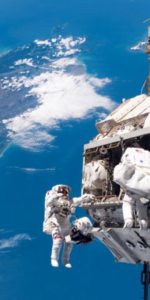
Later tonight NASA’s New Horizons spacecraft will mark another milestone on its long 3 billion mile journey to explore Pluto and its moon Charon, coming within a mere 930 million miles of its dwarf planet target.
The spacecraft, launched from Cape Canaveral Florida in 2006, has already passed Mars, Jupiter, Saturn, and Uranus on its voyage – and it still has 3 years of travel time before its historic pass of Pluto in the summer of 2015. The distances New Horizons is covering are so vast that it is not even measured in miles, but in astronomical units – or AU. One AU is considered to be the average distance between Earth and the Sun, roughly 93 million miles. Tonight the spacecraft will surpass a distance of 22 AU from Earth, or 22 times further from Earth than Earth is from the Sun. Few spacecraft have ever travelled these kind of distances, with only four other spacecraft ever crossing into interplanetary space so far from the sun – Pioneers 1 and 2, and Voyagers 1 and 2.
The spacecraft itself is currently in hibernation mode, sleeping as it pushes towards Pluto at 34,000 miles per hour, covering nearly a million miles per day. In April, operators at Johns Hopkins University in Maryland will awaken the spacecraft to perform a series of systems and instrument tests to ensure it is healthy and fully operational as it pushes for a final approach with Pluto.

The next big milestone comes in late summer 2014, when New Horizons passes the orbit of Neptune 11 months prior to its encounter with Pluto. The main science mission begins in February 2015, as the spacecraft will be close enough to Pluto to begin real scientific observations as it comes ever closer to its fly by in July 2015. The spacecraft is traveling so fast that it won’t be able to slow down enough to put itself into an orbit around Pluto, but instead will fly by the dwarf planet at 30,000 miles per hour – giving scientists back on Earth one shot at exploring the mysterious heavenly body as the spacecraft comes within 6,000 miles of Pluto’s surface.
In the 24 hours during New Horizons’ pass of Pluto, a plethora of data and imagery will be pouring in from the spacecraft as it explores Pluto and its moon Charon. If there are other moons orbiting Pluto, or if rings are present, New Horizons will see them. Periodic mapping of their surfaces will tell scientists what Pluto and Charon are made of, what the surface temperatures are, what changes are regularly occurring in the atmosphere, what the atmosphere is made of, and hi-res images of up to 50 megapixels will show us Pluto in a way researchers have only been able to imagine. It is also expected that Pluto’s true diameter will be answered, among a multitude of other scientific objectives that mission operators have set out to accomplish.

After completing its primary objectives with Pluto and Charon, New Horizons will continue on its journey to the farthest points of our known solar system and fly past one or more Kuiper belt objects beyond Pluto – as long as targets of interest are in the spacecrafts proximity. It is expected that the Hubble Telescope may be used to point at targets suitable for New Horizons to explore, and the craft should have enough power to maintain communications until 2025.
Missions » New Horizons »




